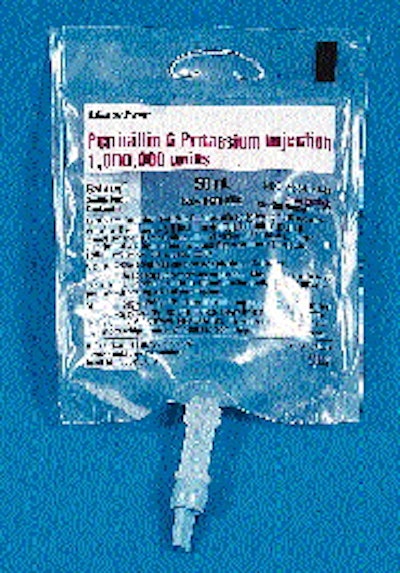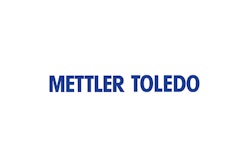Thanks to a combination of labor and material savings, Deerfield, IL-based Baxter Healthcare expects to pay off its $2 million investment in three custom integrated carton packing modules in little more than one year. That's one healthy ROI. Baxter installed the first module in July '95, the other two this past March. All three are located within a Drug Delivery plant, one of seven buildings at the company's Technology Park campus in Round Lake, IL. Drug Delivery produces approximately 15 frozen pre-mix antibiotics, all sold to hospital pharmacies for in-patient treatment. Each module accepts 50-mL bags filled upstream by aseptic vertical form/fill/seal machinery in an adjacent clean room. Filling and cartoning procedures are virtually the same for all product varieties. At the heart of each module is an integrated carton packing system from Goodman Packaging (Lake Forest, IL). It comprises two robotic loading heads, conveyors, electrical system and pneumatic controls, as well as an Allen-Bradley (Milwaukee, WI) SLC 5/03 programmable logic controller that facilitates communications among pieces of equipment on the line. This equipment includes a modified Econocorp (Randolph, MA) carton erector just upstream of the Prototype machine. Downstream equipment includes a Hi-Speed (Ithaca, NY) checkweigher, Longford Equipment (Scarborough, Ontario, Canada) inserter, Econocorp carton sealer, and a labeler (see sidebar, p. 30) from CCL Labeling Equipment (Monrovia, CA). With the exception of semi-automatic labeling, all those tasks were previously performed manually. Automating these tasks saves approximately $1.8 million in annual labor costs. And by unitizing two cartons with two labels rather than adding an outer paperboard sleeve, Baxter saves another $40ꯠ a year in materials. No more workstations "Our reasoning behind carton automation was to generate labor savings, increase our efficiencies and reduce the volume of packaging waste from our operation," explains Janet Stevens, project manager. Considering the previous labor-intensive finishing process, those were understandable goals. "Before we added this equipment," says Jim McMillan, production supervisor, "we had workstations downstream of all filling lines where production associates visually inspected the bags, then folded them over a steel shingling device so that 12 could fit in a carton. They would add an instructional insert, tuck the carton ends in, then place the carton on a conveyor. "At the end of the conveyor another associate would physically weigh the carton to make sure it had the right number of bags," he continues. "They put the filled carton onto another conveyor leading to a downstream station where a label would be applied in a semi-automatic process. Finally, an associate would fit two cartons into an outer paperboard sleeve." Temperature sensitivity The antibiotic parenterals are filled on customized equipment added in '89. Baxter refers to its aseptic filling as the Galaxy(TM) process. Finished bags carry the same name. "The products are temperature sensitive," says Stevens. "They are unstable at warm temperatures as their potency can become ineffective." Therefore products are filled at temperatures between 32°F and 39°F. On average, bags remain at ambient temperatures in the finishing room for only five minutes before they're whisked into coolers for several hours prior to a freeze process where they reach Before carton automation, product stayed at ambient temperatures for 13 minutes on average. Depending on the specific antibiotic, the bags cannot stay at room temperature for more than one hour. Frozen product is trucked to hospital pharmacies where it's refrigerated and thawed. Once thawed, the refrigerated parenterals must be administered to patients within weeks to maintain efficacy. Bag inspection The 50-mL dose is filled into a 5.5-mil bag comprising polyethylene/nylon/PE, printed in three colors. Filled bags are conveyed from the filling room to the finishing room through a positive air flow entrance. Conveyors carry bags from fillers to carton packing modules. As bags from two fillers move into the finishing room, conveyors are some 20' apart. They continue to carry product closer together until there are side-by-side parallel lines. Two production associates seated on each side of the conveyor visually inspect bags for defects. Baxter expended considerable effort in improving ergonomics for these people. The former workstations required workers to pull bags from the conveyor, then twist around to the inspection station. New chairs, designed at more accommodating heights, foot rests and a second-level conveyor with improved lighting allow associates to visually check bags at one position, without delaying line speeds. "These people are critical because they're the last to see the product before it reaches our customers," says McMillan. Robotic pick-and-place Operators place bags onto a flighted conveyor that takes them into the Prototype system for loading into cartons. Rock-Tenn (Norcross, GA) supplies the 18-pt clay-coated solid unbleached sulphate cartons. Set-up, cartons measure 1115/16" L x 529/32" W x 11/4" H. Wraparound cartons are erected by an Econocorp Econolock forming machine that glues the four corners, conveying cartons about 15' to two stations within the Prototype machine. Each station accommodates bags from one line. By doing this, Baxter segregates bags from each filler, improving product tracking and control. Prototype's two robotic loading heads are servo-driven. The heads move in tandem, each using suction cups to pick up two bags. The heads rise, move back to a position above the cartons, then descend to place the bags into the open carton. Four bags are placed in three rows in the carton, using a shingled pattern to maximize the number of bags that will fit into the carton. The filled cartons discharge downstream as two new cartons move into position for the next fill. Controlling the heat Filled cartons convey past the Hi-Speed checkweigher that's programmed by Baxter to verify weight. A green light on the unit signals the carton is within the appropriate weight range, a red indicates an overweight, a white an underweight. Improper weights are diverted past a gate for reworking. Cartons then proceed to the Longford inserter where a single printed instructional insert is added. Cartons make a right-angle turn into the Econocorp Econolock sealing machine for carton closing and sealing. Unlike the previous tuck-style end-load cartons that only required operators to tuck in end flaps, the new cut-and-scored cartons must be glued shut. The Econolock uses a set of fingers to spot apply dabs of glue in three places on the open top. The carton moves forward beneath a compression bar that closes it. The carton then indexes into a vertical compression station to allow the glue to bond properly. The vertical frame snugly holds up to seven cartons. An Allen-Bradley controller helps Baxter monitor the time so that no carton containing the temperature-sensitive product remains in the frame too long. Once the glue has set, the top carton is released onto a conveyor for labeling. Meeting challenges Every aspect of Baxter's new cartoning system had to be verified with the pharmaceutical companies that Baxter serves, such as Hoffman-LaRoche, Bristol-Myers Squibb, Pfizer, Glaxo Wellcome and SmithKline Beecham. According to Stevens, these companies provide antibiotics in powder form. Baxter uses the powder to develop the premixed liquid I.V. products. "We also discussed the changes with many of our customers," adds Stevens. "And they were all for it." Executing the entire change took nearly two years. Customers also like the flat bag afforded by the automated process. It's easier for hospitals to store than the folded bag produced via the former manual packing process. Because the product is more evenly distributed than in the folded bag where product is forced into two thicker areas, Baxter expects it will freeze faster than before. Validation testing must still be done to confirm that. Automating carton packing and labeling has pleased Baxter management. "I've been at Baxter for more than 20 years," says production manager Anne Marie Conroyd, "and I've never seen more cooperation between internal departments within Baxter and external suppliers like Prototype and Econocorp, as with this project. Maintenance, engineering and production worked diligently. While the overall cost was considerable, the team looked at options for every aspect of the project as a means of controlling our spending." That tack has proven to be a healthy strategy for Baxter Healthcare, a company whose name carries a strong cachet in the medical community.

































